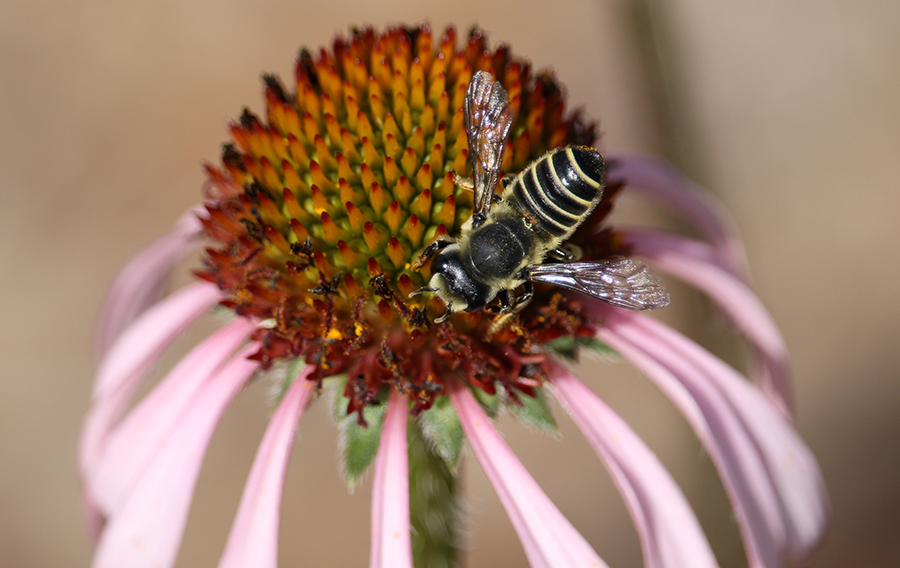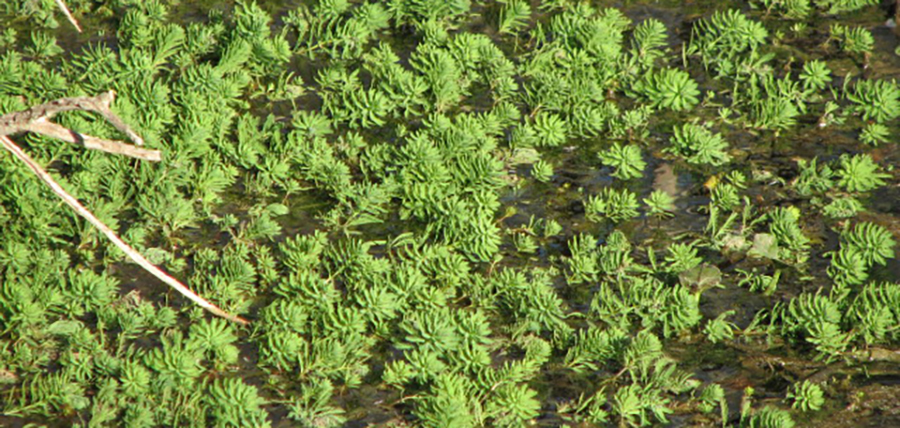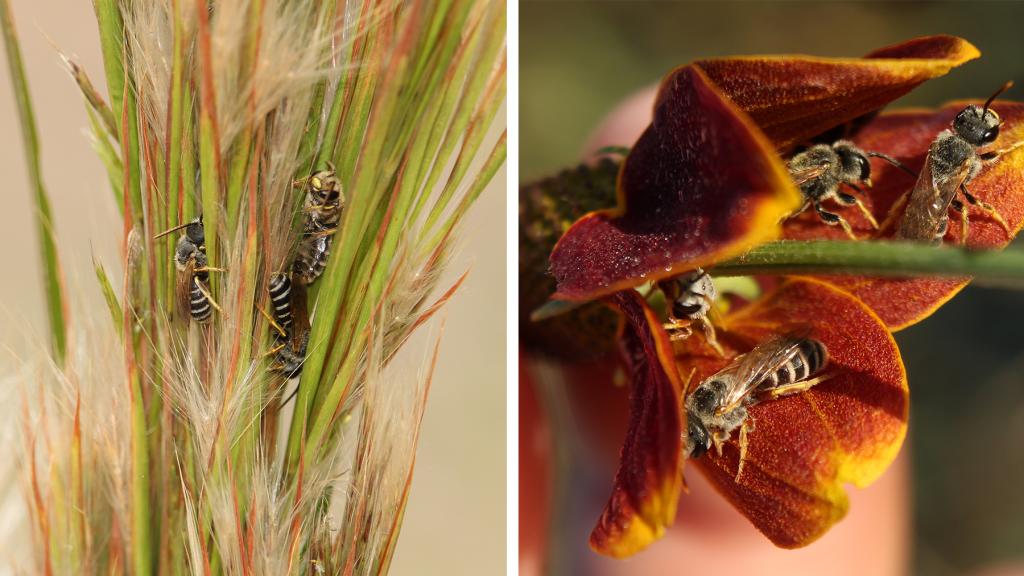Create Wildlife Habitat!
%203x2.jpg)
A certified backyard habitat.
To be complete, wildlife habitat must have food, water, shelter, and space to raise young. Of course, details within each of these component categories can change depending on the species you are trying to attract, but these basic components are needed by all.
Food for Wildlife
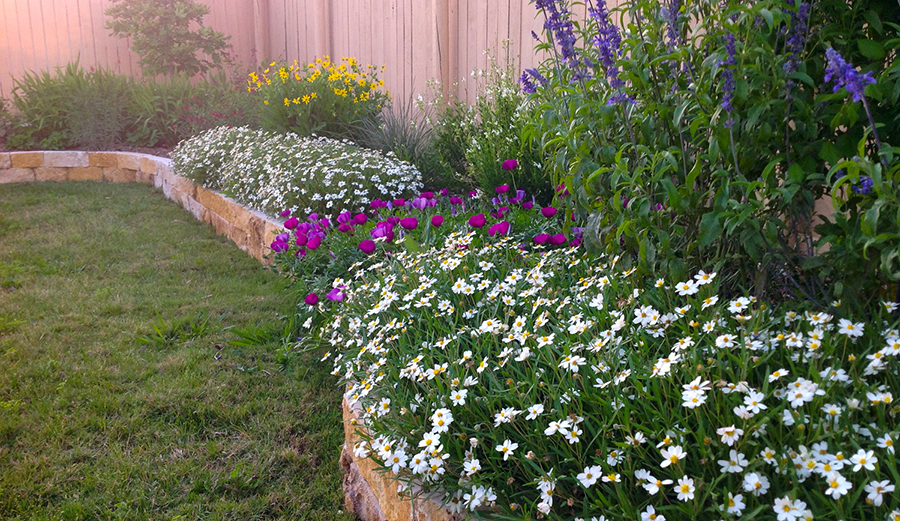
A native landscape.
Native plants originated here and are the best way to feed wildlife. They are essentially wildlife feeders that refill themselves and don't need to be cleaned! In Austin, there are two primary ecological zones that are roughly divided by MoPac. To the west lies the Edwards Plateau ecoregion. To the east lies the Blackland Prairie ecoregion with some Post Oak Savannah mixed in. It's critical to understand which ecoregion you are in when deciding what to plant for native food sources in your wildlife habitat.
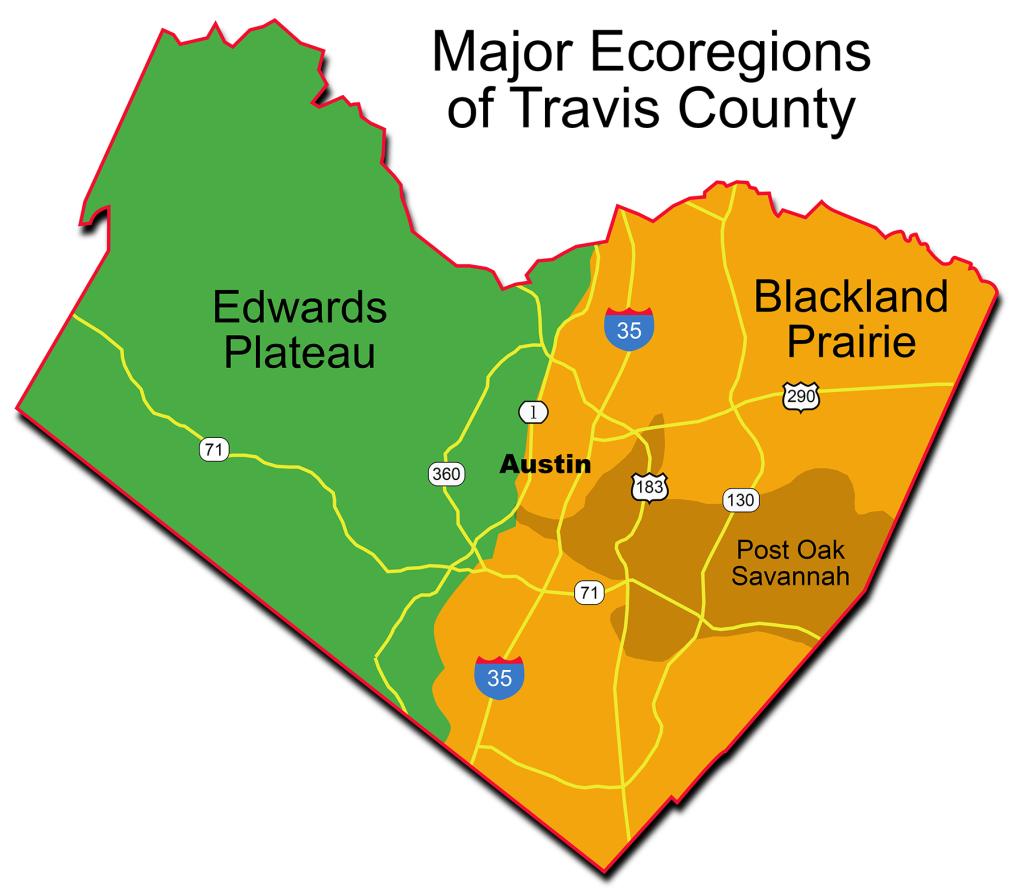
Ecological regions of Travis County.
Resources for Austin Native Plants:
Native Plant Society of Texas Plant Database
Texas Wildscapes Plant Guidance by Ecoregion
Ladybird Johnson Wildflower Center - Recommended Plants for Central Texas
A leafcutter bee on Coneflower.
Where can I buy native plants?
Most nurseries and gardening sections of home improvement stores carry exotic species. The Native Plant Society of Texas has initiated the NICE! Native Plant Partner program to help homeowners locate native plant suppliers. However, many native species aren’t common in the commercial nursery trade but are grown by native plant enthusiasts and sold at weekend native plant sales held in the spring and fall in various locations across Central Texas. Simply search online for “Texas native plant sales” to find one near you.
Should I Provide Feeders?
%203x2.jpg)
Backyard wildlife feeders require time and maintenance.
People enjoy watching wildlife at feeders, but if native plants provide year-round food in the form of vegetation, seeds, fruits, nectar, etc., then supplemental feeding is not necessary and can be detrimental or illegal depending on the method. Providing feeders can also artificially increase wildlife populations, which can lead to overcrowding, disease outbreaks, etc. Therefore, man-made wildlife feeders are not recommended. That said, the decision to provide such feeders is one that everyone must make for himself/herself.
Thinking about installing feeders? Consider this:
1. Can you accomplish your goal of feeding wildlife by planting native plants? If so, this is the easiest and best way to feed wildlife.
2. Is the feeder/method you wish to deploy prohibited? Intentionally feeding deer is prohibited in Austin by city ordinance, so ensure your proposed feeding method does not violate the city's deer feeding ordinance.
3. Are you willing to commit to responsible feeder upkeep and maintenance? When you install a feeder, you become responsible for ensuring your feeder does not harm wildlife. You must commit to providing clean food from a clean feeder. Many birds visiting feeders die each year from seeds contaminated by fungus or other disease-causing pathogens. For more information about common feeder diseases, see the Cornell Lab of Ornithology. One diseased bird that leaves body fluids or waste behind on seeds or surfaces can quickly infect many other birds.
Got sick birds?
If you notice sick birds at your feeder, stop feeding, clean all seed spillage and bring all feeders indoors for at least a week (2 weeks is better). This disperses birds and reduces disease transmission. Replace your seed supply as it may have become contaminated with fungus. Disinfect all feeders by taking them apart and boiling them in water (if the material can stand that) or use a dishwasher on the hot setting. You may also hand wash them either with soap and hot water or with a dilute bleach solution (no more than 1 part bleach to 9 parts water). Rinse them thoroughly and allow them to dry completely before refilling them with clean seed. It's best to have a routine of rotating feeders such that you clean and disinfect one while the other is in use. Then simply fill and hang the clean one while you clean the other. How often you should clean feeders depends on the type of feeder and weather. Hummingbird feeders should be cleaned twice a week in hot weather. Other feeders may go two weeks between cleanings. However, always watch for disease to keep from harming the wildlife you love!
Unintentional Feeding
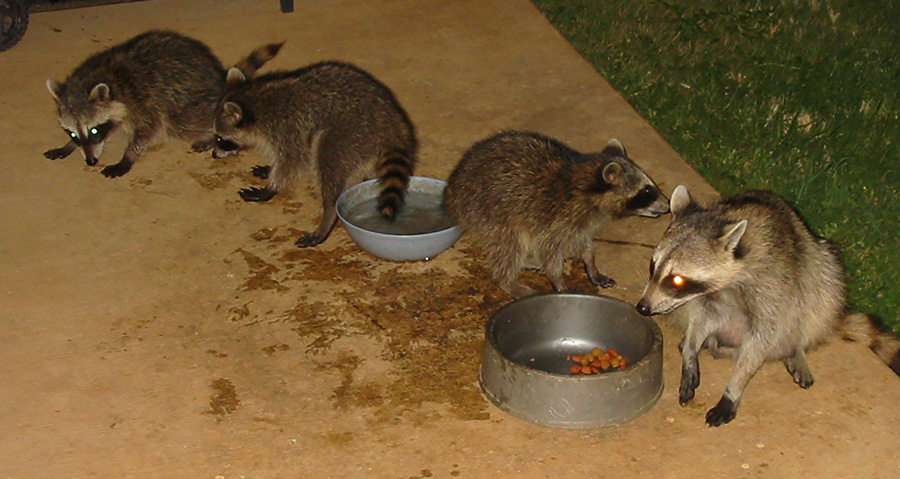
Raccoons will eat uneaten pet food.
Avoid unintentionally feeding wildlife. Keep barbecue grills clean, remove bird seed spillage, and don’t provide access to pet food as these practices will encourage native wildlife (like raccoons and coyotes) that can become a nuisance, as well as non-native rodents like the house mouse, black rat, and Norway rat.
Water for Wildlife
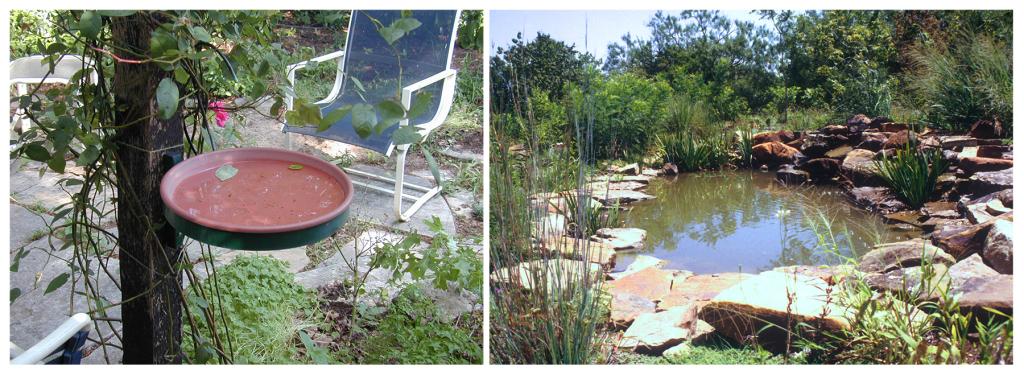
Water features range from birdbaths to ponds.
Providing water for wildlife can be as simple as a birdbath or as involved as a backyard pond with a wetland filtration system. Regardless of your water feature’s size, there are things to consider to ensure it’s safe for wildlife.
Clean Water
%203x1_5.jpg)
Water should be clear, but not chlorinated.
Like the responsibility of maintaining feeders, you must also ensure that your water feature provides healthy water. This does NOT mean it is “chlorinated” clean since chlorine kills many invertebrates that are part of a healthy aquatic system. However, stagnant, algae-infested water features breed mosquitos that can spread disease to humans and wildlife. When considering “healthy” water for wildlife, it should be clear like a clean stream, not green and cloudy.
If you install a birdbath, spray it out and replace the water every 2-3 days to eliminate waste accumulation and prevent disease. If you create a pond, install a pump that recirculates the entire volume of water every 1-2 hours over a waterfall or through a fountain head. This keeps water from becoming stagnant and attracts wildlife to the sound of moving water. You can further improve water quality by circulating water through a homemade bog or wetland filter and remove excess nutrients naturally while growing useful native plants. There are many ways to build a bog filter. For more information, just search online for “building a bog filter” and you’ll find many sites with great information to help tailor a filter that's right for your water feature.
%203x1_5.jpg)
A bog filter is a great way to clean pond water and use the nutrients to grow wetland flowers.
If you still have green cloudy water, you may need to add more plants, or increase your bog filter size, but you may also benefit from adding a barley bale in late winter to prevent excess algae growth during the spring/summer. These come in different sizes, so conduct an online search for “pond barley bales” and find the right size for your pond. As the barley bale decomposes, it helps control algae.
%20barly%20bale%203%20x%201_5.jpg)
Small barley bales help control algae.
Water Feature Safety
When installing a water feature, design it so it’s not a drowning hazard for children. It’s good for kids to experience the wonders of nature, but it’s our job to help keep them safe. If you install a pond, treat it like a pool when thinking about safety. Decorative fencing or planted barriers help keep kids from accidentally falling in.
Similarly, design the sides of your water feature to facilitate ease of exit for any wildlife that may fall in and need to exit. Many pre-formed ponds have smooth edges with steep, straight sides. Wildlife can fall in as they try to drink and can’t escape. It’s best to have a gently sloping side that allows wildlife to enter to the desired depth and easily exit. Liner ponds offer this flexibility. However, if you have a steep-sided pre-formed pond, simply stack stones in the pond in a stair-step pattern at the edge to allow wildlife to enter and exit easily.

(Left) A pre-formed pond with steep, slick sides. (Right) Stones placed adjacent to the edge to provide safe entry and exit.
Moving water and dragonflies can help keep mosquitoes under control, but to add to your defenses, you can also add “BT dunks” and native mosquito fish (Gambusia affinis) to your water feature. BT dunks are wafers you can purchase that contain Bacillus thuringiensis (BT), a bacterium that attacks mosquito larvae but does not harm other wildlife. Drop these in according to the instructions and let them work for you. Just conduct an online search for “BT dunks” to find suppliers or visit a local organic garden center. Mosquito fish, as the name implies, eat mosquito larvae. They are 2-3 inches long, native to Central Texas, and very hardy. The big chain pet centers don’t carry them in stores, so check local independent fish stores for availability or have them shipped to you. If your water feature has plants, some algae, and is not kept overly clean, mosquito fish can usually fend for themselves and be fine feeding on natural food that enters the pond. If not, you may have to feed them fish food flakes. This native species is greatly preferable to exotic fish as exotics can be washed or carried to local waterways and become problematic when established.

(Left) A "BT dunk" in a pond. (Right) Native mosquito fish (Gambusia affinis).
Ecosystem Safety
Exotic plant species pose a significant threat to local ecosystems. Entire ecosystems have been decimated by a single exotic species that has gotten established in the wild and collapsed the system. Giant salvinia is an example. It is an exotic aquatic species that escaped water gardens and aquariums, became established in natural areas, and has decimated local ecosystems. Other examples include water hyacinth, purple loosestrife, parrot feather, and water lettuce to name a few. Unfortunately, the pond / aquarium industry sells many exotic species that can/will wreak havoc in local ecosystems if/when they escape our backyard ponds. To keep our natural areas safe, refuse to buy exotic plants.
Exotic parrot's feather (Myriophyllum aquaticum) invading a natural wetland.
Native aquatic species not only provide food and shelter for wildlife that visit or inhabit your water feature, but also oxygenate and polish water, helping keep algae in check. Natives that thrive underwater include hornwort (Ceratophyllum demersum) and eel grass (Vallisnera americana). Floating leaf species are rooted in pots underwater, but their leaves grow to the surface and float. These include white water lily (Nymphaea odorata), spatterdock (Nuphar lutea advena), American pondweed (Potamogeton nodosus), and Illinois pondweed (Potamogeton illinoensis).
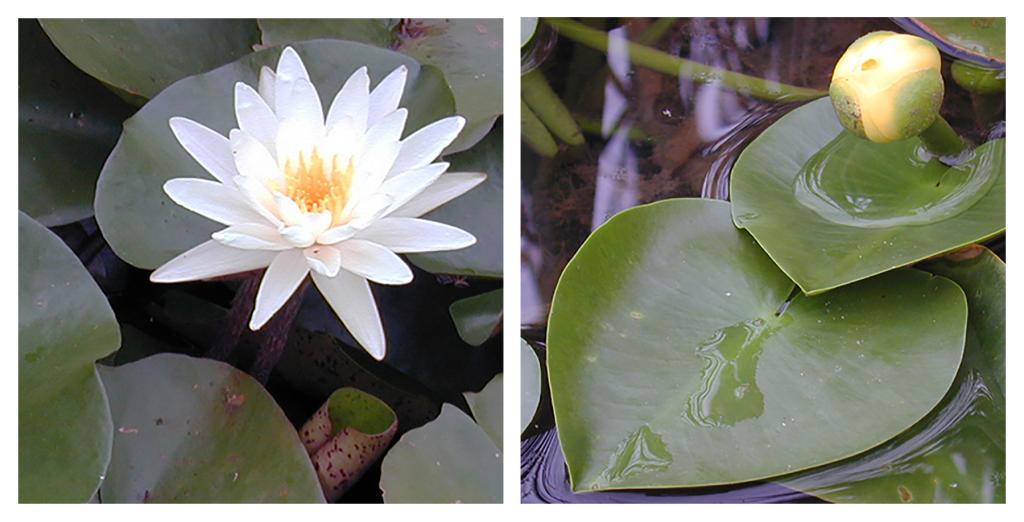
White water lily (left) and spatterdock (right) can be used instead of exotic species.
Emergent species need to be in a pot that is submerged, yet their leaves and flowers emerge from the water. Natives in this group include pickerel plant (Pontederia cordata), arrowhead (Sagitaria lancifolia), and lizard’s tail (Saururus cernuus) which may get too large for most backyard ponds.
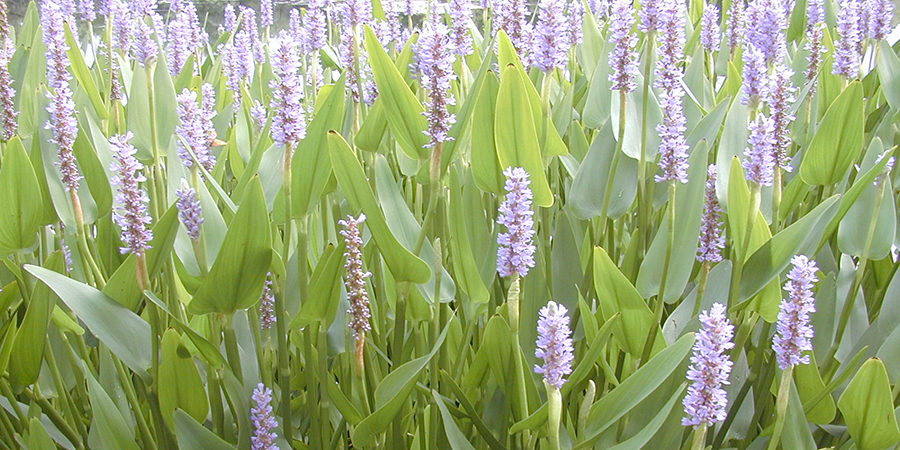
Pickerel plant is a great native emergent species for ponds.
Wetland edge species like “wet feet,” or having their roots partially submerged. These species can be planted in an elevated pot, so it is mostly out of the water or in a bog so most of their roots are not submerged. These species include cardinal flower (Lobelia cardinalis), fall obedient plant (Physostegia virginiana), spring obedient plant (Physostegia angustifolia), spider lily (Hymenocallis liriosome), and bushy bluestem (ornamental grass) (Andropogon glomeratus).
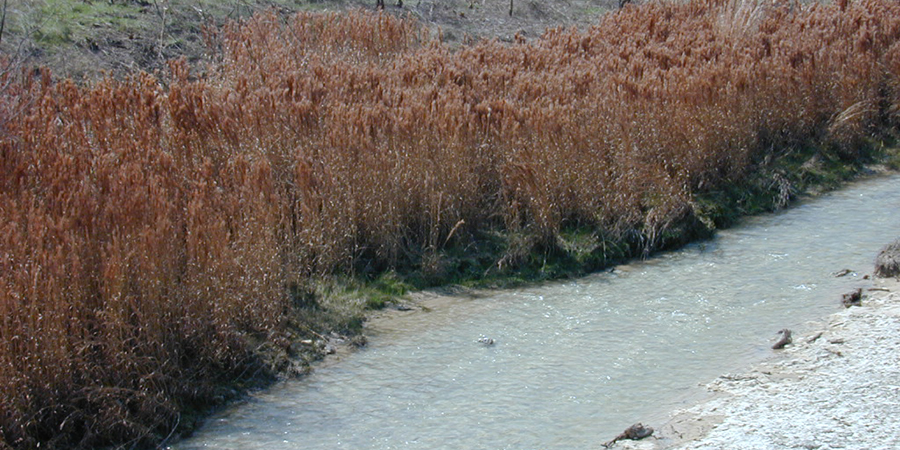
Bushy bluestem in winter color growing naturally along a stream bank.
Shelter for Wildlife
Ligated furrow bees sheltering in bushy bluestem (left) and beneath an upright prairie coneflower (right).
Providing shelter naturally is best. Planting a diversity of native understory (shade-loving) plants beneath the canopies of trees increases the habitat value of those spaces. Such plants provide shelter for nesting and escape from predators. They also provide nectar, seeds, berries, and vegetation upon which wildlife can feed.
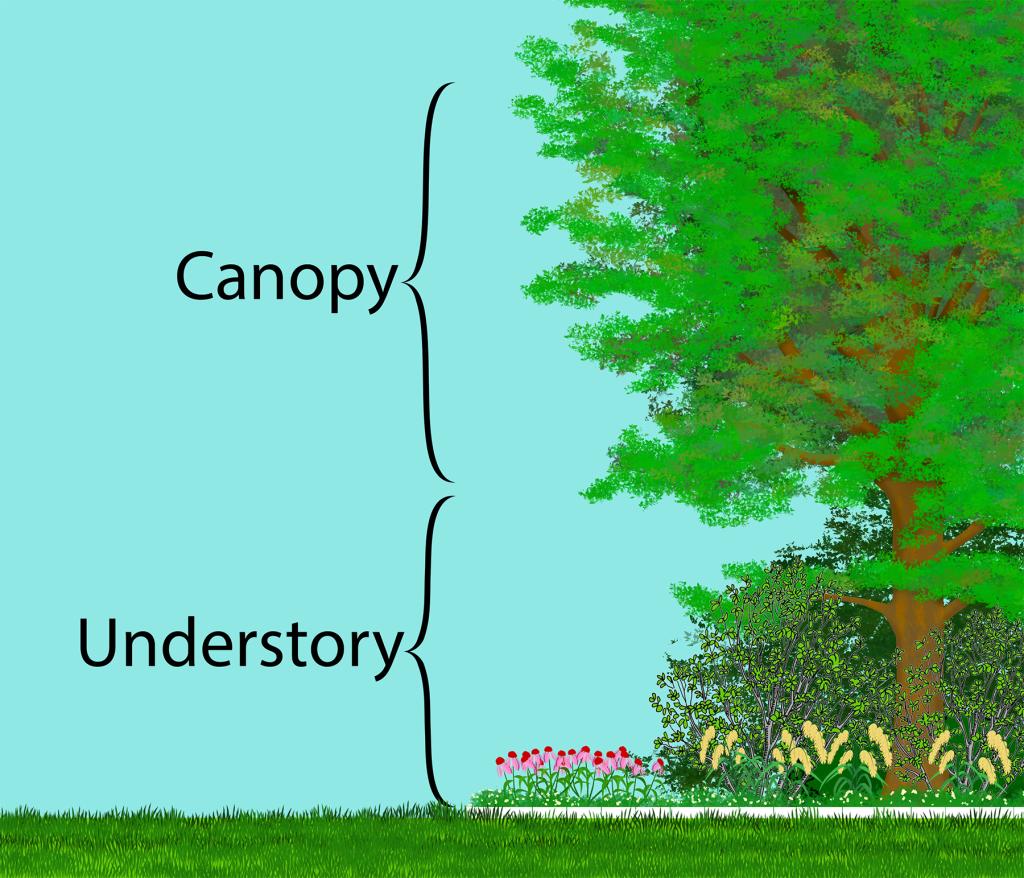
Landscape layers in a backyard habitat.
Once you have created your habitat, it is critical to manage it well to provide safety for wildlife you attract. Many well-intentioned people do landscaping tasks in their habitats that inadvertently harm the wildlife they love. For example, many native invertebrates (butterflies, moths, bees, etc.) overwinter nestled within fallen leaves or incubating within spent flower stalks.
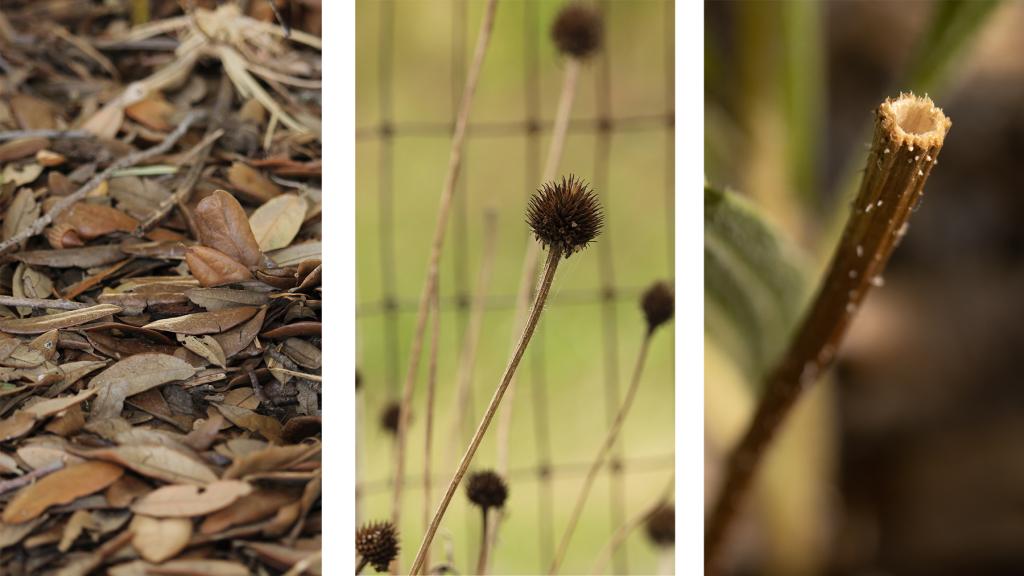
(Left) Fallen leaves on the landscape. (Middle) Spent purple coneflower stalks. (Right) Purple coneflower stalk trimmed and left standing for a native bee nesting site.
By raking, mulching, or removing fallen leaves, homeowners unknowingly destroy pollinators they have worked hard to attract. Similarly, by removing spent flower stems after the growing season, homeowners may remove the next generation of pollinators overwintering inside. Therefore, keep fallen leaves on your landscape. Trim spent flower stalks at a height of 8-24 inches and let them stand. By doing so, you will provide nesting sites in hollow stems and overwintering cover in the leaf layer. For more information, see the Xerces Society for Invertebrate Conservation’s "Leave the Leaves" and "Save the Stems" initiatives.
Reduce or Eliminate Pesticides
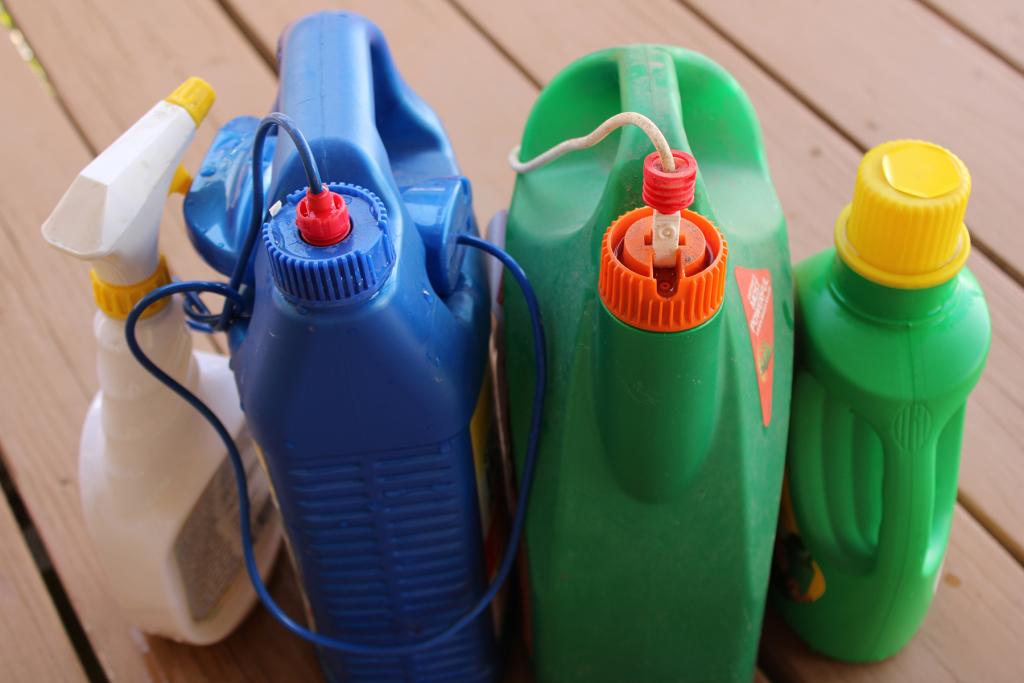
Pesticides can negatively impact native insects and, in turn, the wildlife that feeds on them.
It’s preferable to reduce or eliminate harsh chemical pesticides in a wildlife habitat. Instead, consider plants to be food for wildlife and expect them to be nibbled on. That’s the point of planting them. Native plants attract species that feed on them. Those species then attract other species that feed on them, and the cycle continues. If you must deploy a pesticide, use the least toxic option and only apply the minimum needed. Especially avoid pesticides that are classified as neonicotinoids (“nee-oh-nik-oh-tin-oids”). This class of pesticide is applied to the soil and is then incorporated into plant tissues. Insects that eat the plant, or partake of the nectar/pollen, die. Common neonicotinoid products contain one of the following active ingredients: acetamiprid, clothianidin, dinotefuran, or thiamethoxam.
Nesting Shelter
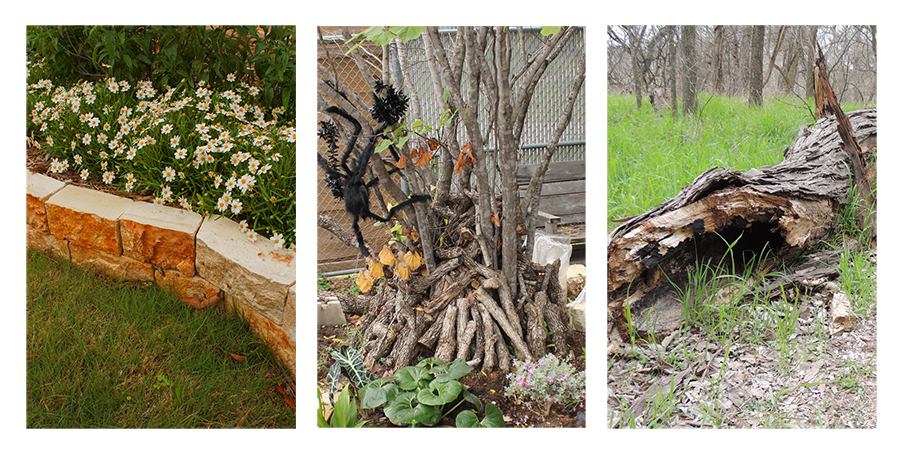
Shelter for small species can be provided by dry-stacked stones (left), wood piles (middle), or hollow logs (right).
Though native plants provide nesting habitat for many species, some require other types of shelter. Most of our native bees nest in tunnels in the soil or in dead wood. Other species use crevices in rock piles or find protection in wood piles or hollow logs. Fireflies need decaying wood to complete their life cycle. Therefore, it’s important not to mulch all bare soil and not to “clean up” all fallen woody material.
Artificial Nesting Structures – should or shouldn’t we provide them?
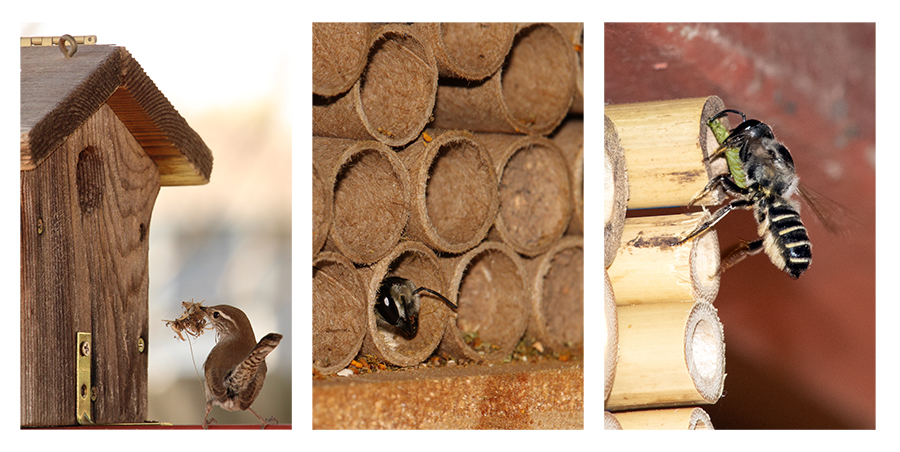
Artificial nest structures like birdhouses (left) or bee tubes (middle and right) can be enjoyable, but require commitment to ensure they don’t encourage disease, predators, or parasites.
Deciding whether to provide artificial nest boxes is like providing feeders. If you create habitat with native plants and natural shelter, wildlife shouldn’t need a nest box. However, many people enjoy providing them and watching species they love benefit from them. Like feeders, providing nest boxes requires responsible management.
Know what NOT to do…
No matter how cute they may be, avoid fancy bird houses with perches on the front. Our native species don't need perches. Perches encourage exotic English sparrows, which compete with our native birds for food. Install nest boxes designed for the species you want to attract since the entry hole diameter and the inside dimensions of the box will be designed for that species. This will also help exclude unwanted exotic species. If you notice English sparrows or European starlings using your bird house, remove the house or actively manage against those species as they harm our native bird populations. Finally, buy a house that is easy to clean. Most reputable nest boxes come with a panel that can be lifted for cleaning and monitoring nest contents (if need be).
%20small.jpg)
When providing nest sites for native bees, avoid treated wood and small wooden blocks with lots of holes. A chamber that’s less than 6” deep, will produce mostly males as the female lays male eggs at the back of the hole and females at the front. If the hole is less than 6” deep (like bee blocks made from 4x4 lumber) she won’t have the depth to produce enough females. Also, concentrating many holes in a small area allows predators and parasites to magnify their impact. Finally, nesting blocks used year after year quickly become infested with mites that greatly hinder breeding success.
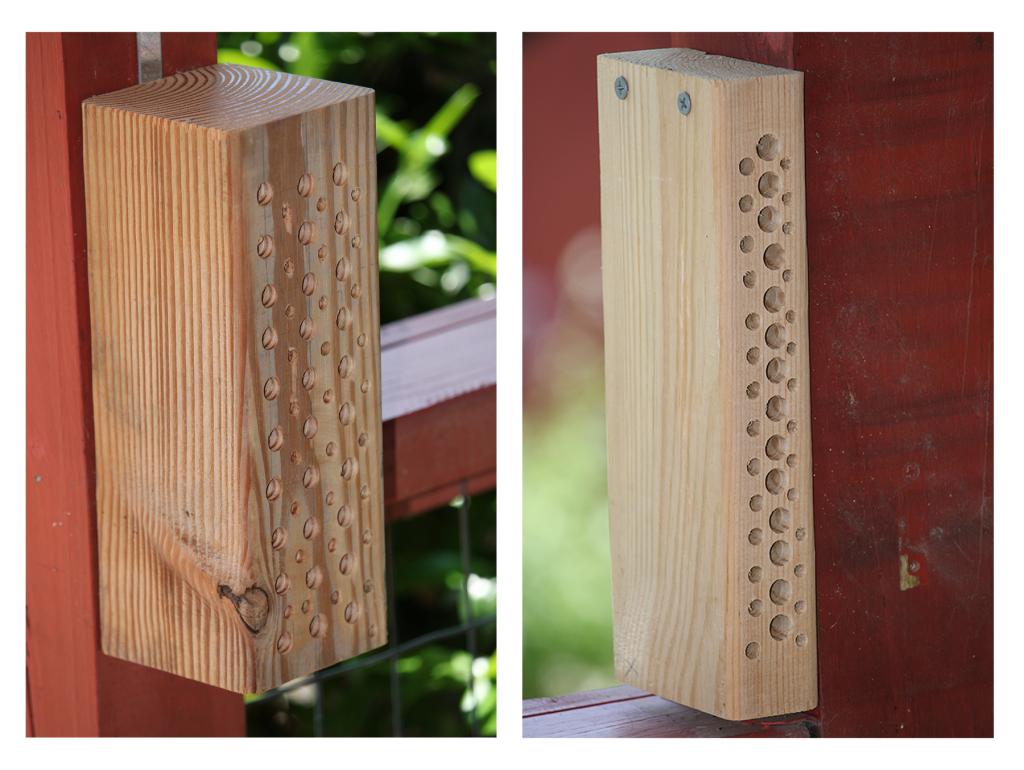
These bee blocks demonstrate what not to do. They are not deep enough and encourage parasites and predators.
To address these problems, use a structure that is at least 6” deep and holds cardboard straws (not plastic) for nesting chambers. Once bees emerge, these straws can simply be discarded, and mites/diseases will be discarded with them. Place a box with new straws in a different location the following year.
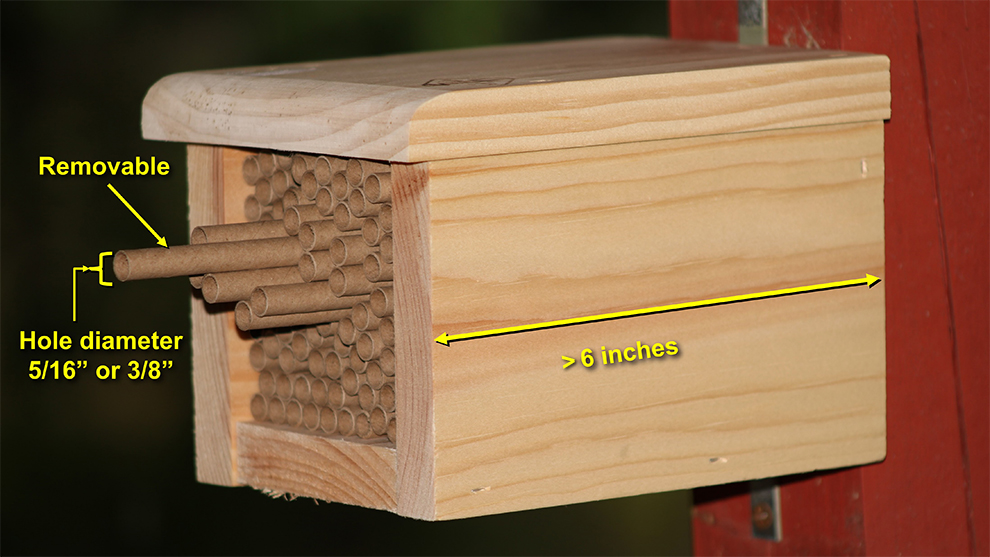
This bee house design allows for chambers to be removed and discarded once young have emerged, thus reducing potential parasites and disease.
Better still, drill a few holes (deeper than 6”) in cut sections of natural limbs and scatter them throughout your landscape to naturally decompose in the weather. This will disperse brood chambers and allow them to degrade in time, thus reducing the impact of parasites and disease.
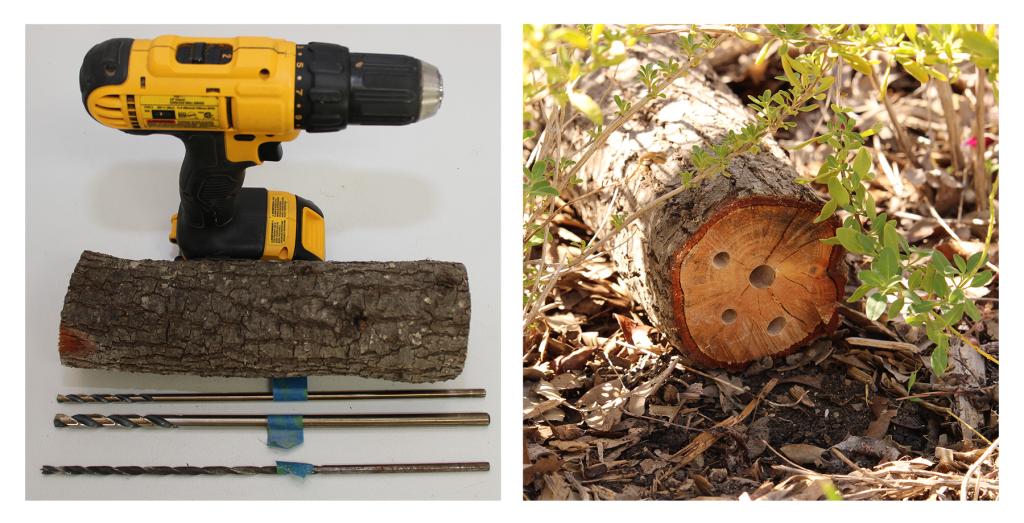
You can make native bee nesting chambers by drilling holes in cut limbs and placing them in your landscape.
To make these, you will need a drill and several long drill bits of varying diameters (1/4”, 5/16”, 3/8”). The size of the hole will determine the types of species that use it. Put a piece of tape on each drill bit at 6.5” to help gauge how deep you are when drilling. Carefully drill a few holes 6” or deeper (of varying diameters) in sections of cut limbs and place them throughout your landscape.
Impact of artificial lighting
Artificial lighting negatively impacts wildlife in many ways according to the National Wildlife Federation. Some nocturnal species are known to avoid areas that are lit during the night. Others, like sea turtles or insects are often drawn to artificial lighting with fatal results. Such lighting has also been shown to impact firefly mating or bird migration. Each of us can do our part by reducing nocturnal lighting on our property.
There are several ways to provide security around your home while minimizing artificial light pollution. Solar powered motion-sensing lights require no wiring and can be placed anywhere and set to illuminate at night for a short period when motion is detected. You can also install motion sensing light bulbs in your porch or driveway sconces that illuminate when motion is detected. This allows an area to remain dark most of the time while still providing security.
%20cleaned%203x1.jpg)
Solar powered motion-sensing lights shine only when needed.
Additionally, small rechargeable wireless security cameras can be mounted anywhere around your home and can operate via infrared light (invisible to humans). There are several affordable camera systems on the market today. Such cameras monitor areas and will send alerts (with video) to your phone should motion be detected. This way, you can have peace of mind without saturating your landscape with light.
%203x2.jpg)
Small, affordable wireless security cameras provide security and limit light pollution.


